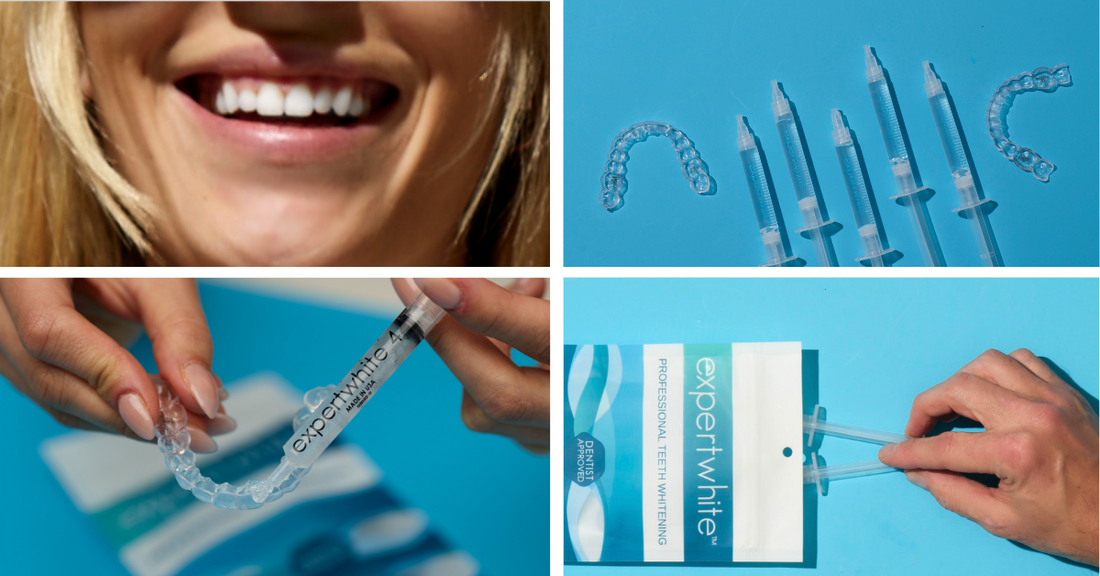Carbamide peroxide (CP) is a stabilized Hydrogen peroxide (HP) formula.
CP is similar to HP but in a more stable formula, so it does not need to be refrigerated. CP also breaks down at a slower rate than HP.
6% HP = 22% CP12% HP = 35% CP
16% HP = 44% CP
Is carbamide peroxide (CP) better than hydrogen peroxide (HP) for teeth whitening?
No. Both hydrogen peroxide (HP) formulas and carbamide peroxide (CP) formulas provide the exact same whitening results.
Why is Carbamide Preferred as a tooth whitening formula?
Carbamide Peroxide breaks down at a slower rate thereby having more time to access and break apart stubborn stains from coffee, smoking, tea and red wine etc that has penetrated the tooth enamel and needs to be soaked out.
Carbamide can be stored at room temperature, Hydrogen peroxide should be refrigerated.
A journal published by ADS (American Dental Association) showed that while carbamide peroxide shows slightly faster results at first, products containing both ingredients produce precisely the same results. Mar 5, 2018
What is the highest level of peroxide for teeth whitening?
6% HP = 22% CP12% HP = 35% CP
16% HP = 44% CP

Does carbamide peroxide really whiten teeth?
Carbamide peroxide gradually enters tooth enamel, transforming into hydrogen peroxide. It then oxidizes pigmented molecules within the tooth structure, breaking down dark-colored compounds and lightening the natural tooth shade.
Where can I buy Carbamide Peroxide?
Expertwhite teeth whitening Gels has been dentist-trusted and used for 20 years for in-office and home whitening. It may be purchased here.
The bottom line?
CP Travels well. Does not need to be refrigerated and has a far longer shelf-life than HP. It also breaks down at a slower rate causing reduced chances of tooth sensitivity.
What makes expertwhite special?
Formulated to a near neutral PH of the mouth, for reduced chances of sensitivity, expertwhite delivers professional teeth whitening results to the whitest shade possible of the natural tooth color.
California USA, Since 2003. Dentist trusted for 20 years.
Shipping:
Cruelty-Free:
Expertwhite products are not tested on animals. We do not use animal products in our teeth bleaching gels, nor do we support animal testing.
Shelf Life:
Ingredients:
Gel Strengths:
Carbamide Peroxide (CP) vs Hydrogen Peroxide (HP):
10% Hydrogen Peroxide = 35% Carbamide Peroxide
15% Hydrogen Peroxide = 44% Carbamide Peroxide
LED / Lamp Whitening:
Near-Neutral PH:
Safety:
Non-Toxic:
Further reading: Clinical Studies
A clinical evaluation of carbamide peroxide and hydrogen peroxide whitening agents during daytime use
National Library Of Medicine NIH https://pubmed.ncbi.nlm.nih.gov/10986827/
G R Mokhlis B A Matis,, M A Cochran, G J Eckert
Affiliations expand
- PMID: 10986827
- DOI: 10.14219/jada.archive.2000.0380
Abstract
Background: Vital tooth bleaching for aesthetic reasons has gained popularity during the last few years. However, few studies have investigated the efficacy of daytime bleaching products. This double-blind in vivo study aimed to evaluate the effectiveness of 20 percent carbamide peroxide, or CP, and 7.5 percent hydrogen peroxide, or HP, during daytime use. The degree of color change, color relapse, and tooth or gingival sensitivity were evaluated.
Methods: Twenty-four patients participated in this study. The bleaching gels were randomly applied to the right and left maxillary anterior teeth. Patients were shown how to place the two bleaching agents in a custom tray for one hour, twice a day for two weeks. Patients returned in one, two, three, six, and 12 weeks for color evaluation with colorimeter and shade guides and to take color slide photographs. The authors evaluated sensitivity by asking the patients to record daily for 21 days any tooth or gingival sensitivity they experienced.
Results: The 20 percent CP resulted in significantly more lightness than the 7.5 percent HP during the first 14 days of the study. However, at the end of the study, there was no significant difference between products concerning tooth lightness. In addition, the authors found no statistically significant difference between products concerning gingival or tooth sensitivity.
Conclusions: CP and HP are effective at-home bleaching agents when preferred during daytime bleaching.
Clinical implications: Dentists using daytime bleaching can select either CP or HP.







